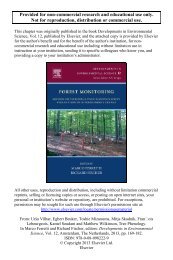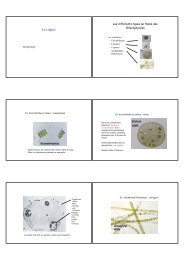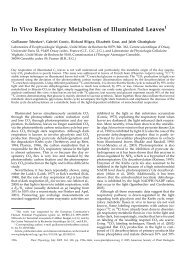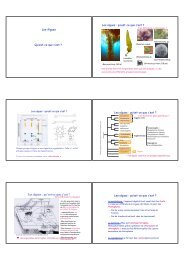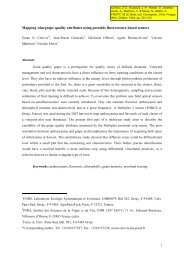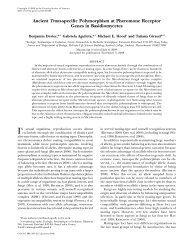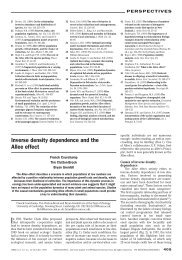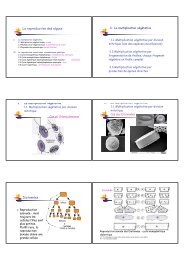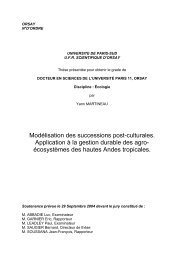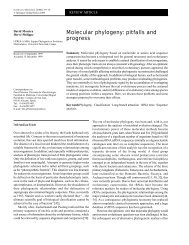220 ResearchNewPhytologistPlant characteristicsTo assess factors that may explain <str<strong>on</strong>g>the</str<strong>on</strong>g> disease frequencies,informati<strong>on</strong> was compiled for <str<strong>on</strong>g>the</str<strong>on</strong>g> life-span (annual orperennial), petal limb length, and flower color <str<strong>on</strong>g>of</str<strong>on</strong>g> each<strong>species</strong> (see Supporting Informati<strong>on</strong> Table S1). Specieslisted as biennial were included with annuals, and <strong>species</strong>listed variably as annual ⁄ perennial or biennial ⁄ perennialwere included with perennials. Biennial <strong>species</strong> wereincluded with annuals because, like annuals, individuals d<strong>on</strong>ot exhibit repeated flowering which is necessary for <str<strong>on</strong>g>the</str<strong>on</strong>g> persistence<str<strong>on</strong>g>of</str<strong>on</strong>g> this pollinator-transmitted disease over successiveseas<strong>on</strong>s (Thrall et al., 1993); moreover, <strong>species</strong> with a winterannualhabit are sometimes described in <str<strong>on</strong>g>the</str<strong>on</strong>g> literature asbiennial. The floral trait <str<strong>on</strong>g>of</str<strong>on</strong>g> petal limb length was used as aproxy for flower size; a previous study had suggested a positiverelati<strong>on</strong>ship between flower size and disease incidence(Thrall et al., 1993). The darkness <str<strong>on</strong>g>of</str<strong>on</strong>g> flower color was alsoinvestigated because we were c<strong>on</strong>cerned that it might biascollecti<strong>on</strong> <str<strong>on</strong>g>of</str<strong>on</strong>g> diseased plants by collectors, <str<strong>on</strong>g>the</str<strong>on</strong>g> disease beingmore c<strong>on</strong>spicuous <strong>on</strong> white-colored flowers. The darkness <str<strong>on</strong>g>of</str<strong>on</strong>g>flower color was assessed <strong>on</strong> a scale from 1 to 4: 1, white; 2,white-yellow, white-green, or white-pink; 3, pink, violet,red-white, or lilac; 4, red, red-violet, dark red, or dark violet.Data <strong>on</strong> plant traits were ga<str<strong>on</strong>g>the</str<strong>on</strong>g>red from various sourcesincluding floras (Flora <str<strong>on</strong>g>of</str<strong>on</strong>g> North America,Rabeler &Hartman, 2005; Flora <str<strong>on</strong>g>of</str<strong>on</strong>g> China, Zhou et al., 2001; AtlasFlorae Europaeae, Jalas & Suominen, 1988; Flora iberica,<strong>on</strong>line at http://www.bioscripts.net/flora/) and publishedarticles (Desfeux et al., 1996; Jürgens et al., 1996, 2002a,b;Burleigh & Holtsford, 2003; Popp et al., 2005; Jürgens,2006; Popp & Oxelman, 2007). Particular efforts weremade to c<strong>on</strong>firm <strong>species</strong> identificati<strong>on</strong>s and avoid cases <str<strong>on</strong>g>of</str<strong>on</strong>g>tax<strong>on</strong>omic syn<strong>on</strong>ymy, principally using <str<strong>on</strong>g>the</str<strong>on</strong>g> Sileneae database(http://www.sileneae.info/boxweb), Internati<strong>on</strong>al PlantNames Index (http://www.ipni.org), and <str<strong>on</strong>g>the</str<strong>on</strong>g> Atlas FloraeEuropaeae (Jalas & Suominen, 1988). While systematicrevisi<strong>on</strong>s are <strong>on</strong>going, this study used <str<strong>on</strong>g>the</str<strong>on</strong>g> current state <str<strong>on</strong>g>of</str<strong>on</strong>g><strong>species</strong> identificati<strong>on</strong>s as operati<strong>on</strong>al tax<strong>on</strong>omic units for<str<strong>on</strong>g>the</str<strong>on</strong>g> analysis <str<strong>on</strong>g>of</str<strong>on</strong>g> disease distributi<strong>on</strong>s.Rates <str<strong>on</strong>g>of</str<strong>on</strong>g> diseaseThe frequency <str<strong>on</strong>g>of</str<strong>on</strong>g> disease within a <strong>species</strong> was assessed using<str<strong>on</strong>g>the</str<strong>on</strong>g> proporti<strong>on</strong> <str<strong>on</strong>g>of</str<strong>on</strong>g> herbarium sheets with plants showingan<str<strong>on</strong>g>the</str<strong>on</strong>g>r-smut symptoms.To identify <strong>species</strong> that showed higher or lower diseasefrequencies than expected, while accounting for differencesin <str<strong>on</strong>g>the</str<strong>on</strong>g> number <str<strong>on</strong>g>of</str<strong>on</strong>g> specimens examined, we used <str<strong>on</strong>g>the</str<strong>on</strong>g> probability<str<strong>on</strong>g>of</str<strong>on</strong>g> deviati<strong>on</strong> from random expectati<strong>on</strong>s (i.e. binomialdistributi<strong>on</strong> probabilities) based <strong>on</strong> <str<strong>on</strong>g>the</str<strong>on</strong>g> diseased proporti<strong>on</strong><str<strong>on</strong>g>of</str<strong>on</strong>g> all perennial specimens. This analysis was restricted toperennial <strong>species</strong> because <str<strong>on</strong>g>the</str<strong>on</strong>g> disease is absent from annuals(see Results secti<strong>on</strong>). Perennial <strong>species</strong> likely to be diseasefreein nature were identified as those where no disease wasfound despite a binomial distributi<strong>on</strong> probability <str<strong>on</strong>g>of</str<strong>on</strong>g> < 0.05for finding zero diseased specimens out <str<strong>on</strong>g>of</str<strong>on</strong>g> <str<strong>on</strong>g>the</str<strong>on</strong>g> number <str<strong>on</strong>g>of</str<strong>on</strong>g>specimens examined based <strong>on</strong> <str<strong>on</strong>g>the</str<strong>on</strong>g> diseased proporti<strong>on</strong> <str<strong>on</strong>g>of</str<strong>on</strong>g> allperennial specimens and employing a B<strong>on</strong>ferr<strong>on</strong>i correcti<strong>on</strong>for multiple independent tests. Plant characteristics <str<strong>on</strong>g>of</str<strong>on</strong>g>flower size and color were tested for correlati<strong>on</strong>s withpositive or negative deviati<strong>on</strong>s from expected numbers <str<strong>on</strong>g>of</str<strong>on</strong>g>diseased specimens <str<strong>on</strong>g>of</str<strong>on</strong>g> perennial <strong>species</strong> using <str<strong>on</strong>g>the</str<strong>on</strong>g> n<strong>on</strong>parametricSpearman’s rank test in spss versi<strong>on</strong> 12 (SPSSInc., Chicago, IL, USA).The percentage <str<strong>on</strong>g>of</str<strong>on</strong>g> perennial <strong>species</strong> in <str<strong>on</strong>g>the</str<strong>on</strong>g> tribe Sileneaeexpected to be diseased in nature was estimated using twomethods. First, <str<strong>on</strong>g>the</str<strong>on</strong>g> per cent diseased was determined am<strong>on</strong>g<strong>species</strong> where <str<strong>on</strong>g>the</str<strong>on</strong>g> binomial probability <str<strong>on</strong>g>of</str<strong>on</strong>g> not finding diseasewas < 0.05, < 0.10 and < 0.20 given <str<strong>on</strong>g>the</str<strong>on</strong>g> number <str<strong>on</strong>g>of</str<strong>on</strong>g>sheets examined and <str<strong>on</strong>g>the</str<strong>on</strong>g> expected overall frequency <str<strong>on</strong>g>of</str<strong>on</strong>g> diseasein perennials (see Results secti<strong>on</strong>). Sec<strong>on</strong>dly, a simulati<strong>on</strong>approach was used. For each <strong>species</strong>, a binomialdistributi<strong>on</strong> probability was calculated for finding at least<strong>on</strong>e diseased specimen. In <str<strong>on</strong>g>the</str<strong>on</strong>g> simulati<strong>on</strong>, a <strong>species</strong> wasscored as being diseased if this calculated probability wasgreater than a uniform random value between zero and <strong>on</strong>e.This simulati<strong>on</strong> attempts to estimate <str<strong>on</strong>g>the</str<strong>on</strong>g> percentage <str<strong>on</strong>g>of</str<strong>on</strong>g><strong>species</strong> that are diseased by including all perennial <strong>species</strong>surveyed ra<str<strong>on</strong>g>the</str<strong>on</strong>g>r than <strong>on</strong>ly <str<strong>on</strong>g>the</str<strong>on</strong>g> most intensively surveyed.The average probability <str<strong>on</strong>g>of</str<strong>on</strong>g> perennial <strong>species</strong> being diseasedwas <str<strong>on</strong>g>the</str<strong>on</strong>g>n calculated across all <strong>species</strong> weighted by <str<strong>on</strong>g>the</str<strong>on</strong>g>number <str<strong>on</strong>g>of</str<strong>on</strong>g> specimens per <strong>species</strong>, and <str<strong>on</strong>g>the</str<strong>on</strong>g> simulati<strong>on</strong> wasaveraged over 1000 iterati<strong>on</strong>s.Phylogenetic basis <str<strong>on</strong>g>of</str<strong>on</strong>g> disease occurrenceTo investigate whe<str<strong>on</strong>g>the</str<strong>on</strong>g>r <str<strong>on</strong>g>the</str<strong>on</strong>g>re was a phylogenetic basis tohigh and low rates <str<strong>on</strong>g>of</str<strong>on</strong>g> disease incidence, a phylogeny wasc<strong>on</strong>structed using chloroplast ribosomal protein rps16intr<strong>on</strong> sequences <str<strong>on</strong>g>of</str<strong>on</strong>g> Silene available in GenBank Nati<strong>on</strong>alCentre for Biotechnology Informati<strong>on</strong> (NCBI) (http://www.ncbi.nlm.nih.gov/). Accessi<strong>on</strong> numbers are availablein Table S2. The <strong>species</strong> were categorized into three groups:perennials with high disease (positive deviati<strong>on</strong>s fromexpected numbers <str<strong>on</strong>g>of</str<strong>on</strong>g> diseased specimens), perennials withlow disease (negative deviati<strong>on</strong>s from expected numbers <str<strong>on</strong>g>of</str<strong>on</strong>g>diseased specimens), and annual <strong>species</strong>. DNA sequenceswere available for 14 perennial <strong>species</strong> with high disease,and this number <str<strong>on</strong>g>of</str<strong>on</strong>g> <strong>species</strong> was chosen from <str<strong>on</strong>g>the</str<strong>on</strong>g> categories<str<strong>on</strong>g>of</str<strong>on</strong>g> perennials with low disease, and from annual <strong>species</strong>.DNA sequences were aligned using ClustalW (http://www.ebi.ac.uk/clustalw/), and phylogenies were rec<strong>on</strong>structedwith <str<strong>on</strong>g>the</str<strong>on</strong>g> mega 4.0 s<str<strong>on</strong>g>of</str<strong>on</strong>g>tware (Kumar et al., 2004)by maximum parsim<strong>on</strong>y analysis using <str<strong>on</strong>g>the</str<strong>on</strong>g> CNI heuristicsearch opti<strong>on</strong>, 100 random additi<strong>on</strong>s <str<strong>on</strong>g>of</str<strong>on</strong>g> sequences, and1000 bootstrap pseudoreplicates. Bayesian posterior probabilitieswere determined using MrBayes versi<strong>on</strong> 3.1, andNew Phytologist (2010) 187: 217–229www.newphytologist.comÓ The Authors (2010)Journal compilati<strong>on</strong> Ó New Phytologist Trust (2010)
NewPhytologist Research 221<str<strong>on</strong>g>the</str<strong>on</strong>g> model <str<strong>on</strong>g>of</str<strong>on</strong>g> molecular evoluti<strong>on</strong> that best fitted <str<strong>on</strong>g>the</str<strong>on</strong>g> datawas determined using jModeltest (Posada, 2008). Under<str<strong>on</strong>g>the</str<strong>on</strong>g> Akaike informati<strong>on</strong> criteri<strong>on</strong> (AIC), <str<strong>on</strong>g>the</str<strong>on</strong>g> data were bestfitted by <str<strong>on</strong>g>the</str<strong>on</strong>g> TPM1uf + G model which assumes equalsrates for three types <str<strong>on</strong>g>of</str<strong>on</strong>g> substituti<strong>on</strong>s (see jModeltest manualfor details) with a gamma distributi<strong>on</strong> (G) <str<strong>on</strong>g>of</str<strong>on</strong>g> site-specificrates. The general time reversible (GTR) model with agamma distributi<strong>on</strong> (G) <str<strong>on</strong>g>of</str<strong>on</strong>g> site-specific rates was used in <str<strong>on</strong>g>the</str<strong>on</strong>g>Bayesian analysis because it is <str<strong>on</strong>g>the</str<strong>on</strong>g> most similar model toTPM1uf + G available in MrBayes 3.1, and it was ranked8th am<strong>on</strong>g <str<strong>on</strong>g>the</str<strong>on</strong>g> 88 models compared with <str<strong>on</strong>g>the</str<strong>on</strong>g> AIC. Priors <str<strong>on</strong>g>of</str<strong>on</strong>g>state frequencies were left at default settings and Markovchains were initiated from a random tree and run until <str<strong>on</strong>g>the</str<strong>on</strong>g>average standard deviati<strong>on</strong> <str<strong>on</strong>g>of</str<strong>on</strong>g> split frequencies remainedbelow 0.01, that is, 600 000 iterati<strong>on</strong>s; posterior probabilitieswere derived from 9000 post-burn-in trees.To test whe<str<strong>on</strong>g>the</str<strong>on</strong>g>r disease status was correlated with lifespan(annual vs perennial) while c<strong>on</strong>trolling for <str<strong>on</strong>g>the</str<strong>on</strong>g> plantphylogeny, a c<strong>on</strong>tinuous Markov model in a maximumlikelihood framework was used, as described by Pagel(1994) and implemented in <str<strong>on</strong>g>the</str<strong>on</strong>g> program Mesquite 2.6(Maddis<strong>on</strong> & Maddis<strong>on</strong>, 2009) with 1000 simulati<strong>on</strong>s.Evidence <str<strong>on</strong>g>of</str<strong>on</strong>g> phylogenetic signal for <str<strong>on</strong>g>the</str<strong>on</strong>g> discrete characters<str<strong>on</strong>g>of</str<strong>on</strong>g> annual vs perennial life-span and presence or absence <str<strong>on</strong>g>of</str<strong>on</strong>g>disease were tested in Mesquite 2.6 by comparing <str<strong>on</strong>g>the</str<strong>on</strong>g>observed state transiti<strong>on</strong> steps against a simulated distributi<strong>on</strong><str<strong>on</strong>g>of</str<strong>on</strong>g> state transiti<strong>on</strong> steps in which <str<strong>on</strong>g>the</str<strong>on</strong>g> character stateswere shuffled randomly am<strong>on</strong>g taxa (Maddis<strong>on</strong> & Slatkin,1991). In this analysis, a smaller number <str<strong>on</strong>g>of</str<strong>on</strong>g> observed statetransiti<strong>on</strong> steps than expected from <str<strong>on</strong>g>the</str<strong>on</strong>g> randomized distributi<strong>on</strong>(based up<strong>on</strong> 95% c<strong>on</strong>fidence intervals) would indicatethat <str<strong>on</strong>g>the</str<strong>on</strong>g> discrete character is determined significantlyby phylogenetic history; <str<strong>on</strong>g>the</str<strong>on</strong>g> simulated distributi<strong>on</strong> <str<strong>on</strong>g>of</str<strong>on</strong>g> statetransiti<strong>on</strong> steps was based <strong>on</strong> 1000 iterati<strong>on</strong>s. These analyseswere intended to assess <str<strong>on</strong>g>the</str<strong>on</strong>g> distributi<strong>on</strong> <str<strong>on</strong>g>of</str<strong>on</strong>g> plant life-spanand disease status ra<str<strong>on</strong>g>the</str<strong>on</strong>g>r than to provide systematic revisi<strong>on</strong>sto <str<strong>on</strong>g>the</str<strong>on</strong>g> group, which are underway elsewhere.Host and <str<strong>on</strong>g>pathogen</str<strong>on</strong>g> distributi<strong>on</strong>sBecause annual <strong>species</strong> were not found to be diseased (seeResults secti<strong>on</strong>), we focused <strong>on</strong> <str<strong>on</strong>g>the</str<strong>on</strong>g> distributi<strong>on</strong>s <str<strong>on</strong>g>of</str<strong>on</strong>g>perennial <strong>species</strong>. Informati<strong>on</strong> <strong>on</strong> <str<strong>on</strong>g>the</str<strong>on</strong>g> geographical distributi<strong>on</strong>s<str<strong>on</strong>g>of</str<strong>on</strong>g> perennial Silene <strong>species</strong> in Europe wasobtained from <str<strong>on</strong>g>the</str<strong>on</strong>g> Atlas Florae Europaeae Database (AFE)(http://www.fmnh.helsinki.fi/english/botany/afe/publishing/database.htm). These data were used to generate <strong>species</strong>richness maps. For comparis<strong>on</strong> with <str<strong>on</strong>g>the</str<strong>on</strong>g> perennial <strong>species</strong>richness map, 10 European Silene <strong>species</strong> were chosen with<str<strong>on</strong>g>the</str<strong>on</strong>g> most significant binomial distributi<strong>on</strong> probabilities forpositive deviati<strong>on</strong>s from <str<strong>on</strong>g>the</str<strong>on</strong>g> expected number <str<strong>on</strong>g>of</str<strong>on</strong>g> diseasedspecimens, and 10 European Silene <strong>species</strong> were chosenwith <str<strong>on</strong>g>the</str<strong>on</strong>g> largest numbers <str<strong>on</strong>g>of</str<strong>on</strong>g> examined specimens where nodisease was found. This strategy was used to maximizec<strong>on</strong>fidence in assigning <strong>species</strong> to <str<strong>on</strong>g>the</str<strong>on</strong>g> two categories <str<strong>on</strong>g>of</str<strong>on</strong>g>plants with regard to observed rates <str<strong>on</strong>g>of</str<strong>on</strong>g> disease; <str<strong>on</strong>g>the</str<strong>on</strong>g> number<str<strong>on</strong>g>of</str<strong>on</strong>g> <strong>species</strong> to include in <str<strong>on</strong>g>the</str<strong>on</strong>g> heavily diseased categorywas arbitrarily set at a positive binomial distributi<strong>on</strong> probability<str<strong>on</strong>g>of</str<strong>on</strong>g> 0.05, totaling 10 <strong>species</strong> in <str<strong>on</strong>g>the</str<strong>on</strong>g> AFE database,and an equal number <str<strong>on</strong>g>of</str<strong>on</strong>g> disease-free <strong>species</strong> was <str<strong>on</strong>g>the</str<strong>on</strong>g>n alsoincluded. In additi<strong>on</strong>, 10 annual Silene <strong>species</strong> were chosenwith <str<strong>on</strong>g>the</str<strong>on</strong>g> largest numbers <str<strong>on</strong>g>of</str<strong>on</strong>g> examined specimens and usedto generate a European distributi<strong>on</strong> map. Am<strong>on</strong>g <str<strong>on</strong>g>the</str<strong>on</strong>g>European perennial <strong>species</strong> <str<strong>on</strong>g>the</str<strong>on</strong>g> correlati<strong>on</strong> between <str<strong>on</strong>g>the</str<strong>on</strong>g> size<str<strong>on</strong>g>of</str<strong>on</strong>g> geographical ranges and <str<strong>on</strong>g>the</str<strong>on</strong>g> positive or negative deviati<strong>on</strong>from expected numbers <str<strong>on</strong>g>of</str<strong>on</strong>g> diseased specimens was testedusing <str<strong>on</strong>g>the</str<strong>on</strong>g> Spearman’s rank test in spss. The geographicalrange for each <strong>species</strong> was determined from <str<strong>on</strong>g>the</str<strong>on</strong>g> totalnumber <str<strong>on</strong>g>of</str<strong>on</strong>g> 50 · 50 km grid points occupied by a <strong>species</strong> in<str<strong>on</strong>g>the</str<strong>on</strong>g> AFE database. Locality data recorded from herbariumlabels <str<strong>on</strong>g>of</str<strong>on</strong>g> diseased specimens were used to generate a globaldistributi<strong>on</strong> map <str<strong>on</strong>g>of</str<strong>on</strong>g> an<str<strong>on</strong>g>the</str<strong>on</strong>g>r-smut disease found in <str<strong>on</strong>g>the</str<strong>on</strong>g>survey.Pathogen DNA sampling and analysisThe ability to obtain <str<strong>on</strong>g>Microbotryum</str<strong>on</strong>g> from herbarium samplesraises <str<strong>on</strong>g>the</str<strong>on</strong>g> questi<strong>on</strong> <str<strong>on</strong>g>of</str<strong>on</strong>g> whe<str<strong>on</strong>g>the</str<strong>on</strong>g>r it is still possible to isolateDNA and characterize relati<strong>on</strong>ships am<strong>on</strong>g <str<strong>on</strong>g>the</str<strong>on</strong>g>se samples,especially as some <str<strong>on</strong>g>of</str<strong>on</strong>g> <str<strong>on</strong>g>the</str<strong>on</strong>g>se specimens would be difficult to resamplein <str<strong>on</strong>g>the</str<strong>on</strong>g> wild. We <str<strong>on</strong>g>the</str<strong>on</strong>g>refore tested whe<str<strong>on</strong>g>the</str<strong>on</strong>g>r DNA couldbe obtained from herbarium collected smut. We includedan<str<strong>on</strong>g>the</str<strong>on</strong>g>r-smut samples infecting <str<strong>on</strong>g>the</str<strong>on</strong>g> host genus Calandrinia,because recent phylogenetic studies (Le Gac et al., 2007) suggestedthat <str<strong>on</strong>g>the</str<strong>on</strong>g> an<str<strong>on</strong>g>the</str<strong>on</strong>g>r smut from this genus (in <str<strong>on</strong>g>the</str<strong>on</strong>g> familyPortulacaceae) falls within <str<strong>on</strong>g>the</str<strong>on</strong>g> clade c<strong>on</strong>taining an<str<strong>on</strong>g>the</str<strong>on</strong>g>r smutsfrom <str<strong>on</strong>g>the</str<strong>on</strong>g> genus Silene. We <str<strong>on</strong>g>the</str<strong>on</strong>g>refore sought to c<strong>on</strong>firm this inour sampling <str<strong>on</strong>g>of</str<strong>on</strong>g> an<str<strong>on</strong>g>the</str<strong>on</strong>g>r smut from Calandrinia based <strong>on</strong> a largernumber <str<strong>on</strong>g>of</str<strong>on</strong>g> herbarium specimens.During <str<strong>on</strong>g>the</str<strong>on</strong>g> herbarium survey, samples <str<strong>on</strong>g>of</str<strong>on</strong>g> <str<strong>on</strong>g>the</str<strong>on</strong>g> infectedan<str<strong>on</strong>g>the</str<strong>on</strong>g>rs were collected, with permissi<strong>on</strong>, from some diseasedspecimens (see Fig. 4). DNA was extracted from infectedan<str<strong>on</strong>g>the</str<strong>on</strong>g>rs using <str<strong>on</strong>g>the</str<strong>on</strong>g> DNeasy Mini Kit (Qiagen), and PCR wasperformed using primers that anneal to <str<strong>on</strong>g>the</str<strong>on</strong>g> variable regi<strong>on</strong>s<str<strong>on</strong>g>of</str<strong>on</strong>g> <str<strong>on</strong>g>the</str<strong>on</strong>g> internal transcribed spacer regi<strong>on</strong> <str<strong>on</strong>g>of</str<strong>on</strong>g> <str<strong>on</strong>g>the</str<strong>on</strong>g> nuclearrRNA genes to amplify <strong>on</strong>ly <str<strong>on</strong>g>Microbotryum</str<strong>on</strong>g> DNA (intraITSforward: 5¢-CTGTTTAACCAGGGCGTGAC; intraITSreverse: 5¢-TGATCTCGAAGGTTAGGATGC). Accessi<strong>on</strong>numbers are available in Table S2. Field-collected material<str<strong>on</strong>g>of</str<strong>on</strong>g> <str<strong>on</strong>g>Microbotryum</str<strong>on</strong>g> from several hosts was also included aspositive c<strong>on</strong>trols (see Fig. 4). DNA sequences were alignedusing ClustalW, and phylogenies were rec<strong>on</strong>structed with<str<strong>on</strong>g>the</str<strong>on</strong>g> mega 4.0 s<str<strong>on</strong>g>of</str<strong>on</strong>g>tware by maximum parsim<strong>on</strong>y analysisusing <str<strong>on</strong>g>the</str<strong>on</strong>g> CNI heuristic search opti<strong>on</strong>, 100 random additi<strong>on</strong>s<str<strong>on</strong>g>of</str<strong>on</strong>g> sequences, and 1000 bootstrap pseudoreplicates.Bayesian posterior probabilities for support <str<strong>on</strong>g>of</str<strong>on</strong>g> tree topologywere determined as described in <str<strong>on</strong>g>the</str<strong>on</strong>g> secti<strong>on</strong> <strong>on</strong> Phylogeneticbasis <str<strong>on</strong>g>of</str<strong>on</strong>g> disease occurrence.Ó The Authors (2010)Journal compilati<strong>on</strong> Ó New Phytologist Trust (2010)New Phytologist (2010) 187: 217–229www.newphytologist.com



